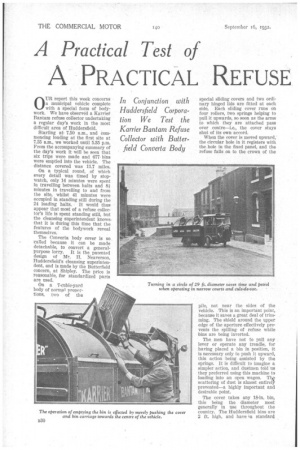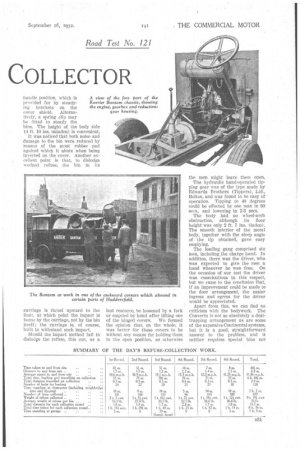A Practical Test of
Page 48

Page 49

Page 50

If you've noticed an error in this article please click here to report it so we can fix it.
A PRACTICAL REFUSE COLLECTOR
0 UR report this week concerns a municipal vehicle complete with a special form of bodywork. We have observed a Karrier Bantam refuse collector undertaking a regular day's work in the most difficult area of Huddersfield.
Starting at. 7.50 a.m., and corn-. mencing loading at the first site at 7.55 a.m., we worked until 5.35 p.m. From the accompanying summary of the day's work it will be seen that six trips were made and 677 bins were emptied into the vehicle. The distance covered was 11.7 miles.
On a typical round, of which every detail was timed by stopwatch, only 14 minutes were spent In travelling between halts and 8. minutes in travelling to and from the site, whilst 41 minutes were occupied in standing still during the 24 loading halts. It would thus appear that most of a refuse collector's life is spent standing still, but the cleansing superintendent knows that it is during this time that the features of the bodywork reveal themselves.
The Converta body cover is so called because it can be made detachable, to convert a generalpurpose lorry. It is the parented design of Mr. H. Neaverson, Huddersfield's cleansing superintendent, and is made by the Butterfield concern, at Shipley. The price is reasonable, for standardized parts are used.
On a 7-cubic-yard body of normal proportions, two of the special sliding covers and two ordinary hinged lids are fitted at each side. Each sliding cover runs on four rollers, two springs helping to pull it upwards, so soon as the arms to which they are attached pass over centre—i.e., the cover stays shut of its own accord.
When the cover is moved upward, the circular hole in it registers with the hole in the fixed panel, and the refuse falls on to the crown of the
pile, not near the sides of the vehicle. This is an important point, because it saves a great deal or trimming. The shield around the upper edge of the aperture effectively prevents the spilling of refuse while bins are being inverted.
The men have not to pull any lever or operate any treadle, for having, placed a bin in position, it is necessary only to push it upward, this action being assisted by the springs. It is difficult to imagine a simpler action, and dustmen told us they preferred using this machine to loading into an open wagon. Tlic, scattering of dust is almost entirely prevented—a highly important and desirable point.
The cover takes any 18-in, bin, this being the diameter most generally in use throughout the country. The Huddersfield bins are 2 ft. high, and have ia standard
handle position, which is provided for by steadying brackets on the cover shield. Alternatively, a spring clip may be fitted to steady the bins. The height of the body side (4 ft. 10 ins. unladen) is convenient.
It was noticed that both noise and damage to the bin were reduced by reason of the stout rubber pad against which it abuts when being inverted on the cover. Another excellent point is that, to dislodge wedged refuse, the bin in it carriage is thrust upward, to the limit, at which point the impact is borne by the carriage, not by the bin itself ; the carriage is, of course, built to withstand such impact.
Should the impact method fail to dislodge the refuse, this can, as a last resource, be loosened by a fork or emptied by hand after lifting one of the hinged covers. We formed the opinion that, on the whole, it was better for these covers to be without any means for holding them, in the open position, as otherwise the men might leave them open.
The hydraulic hand-operated tipping gear was of the type made by Edwards Brothers (Tippers), Ltd., Bolton, and was found to be easy of operation. tipping to 48 degrees could be effected by one man in 60 sees., and lowering in 2-3 Bees.
The body had no wheel-arch obstruction, although its floor height was only 2 ft. 7 ins. (laden). The smooth interior of the metal body, together with the steep angle of the tip obtained, gave easy emptying.
The loading gang comprised six men, including the charge hand. In addition, there was the driver, who was expected to give the men a hand whenever he was free. On the occasion of our test the driver was conscientious in this respect, but we came to the conclusion that, if an improvement could be made to the door arrangement, the easier ingress and egress for the driver would be appreciated.
Apart from this, we can find no criticism with the bodywork. The Converta is not so absolutely a dusttrapping arrangement as are some of the expensive Continental systems, but it is a good, straightforward answer to the problem, and it neither requires special bins nor involves contrivances likely to givel maintenance trouble.
Turning now to the Rarrier Bantam chassis, the low frame height and short wheelbase are commendable, and the advantage of fitting pneumatic tyres is continually noticed on the rough ground. The control position being beside the engine, a commendable degree of accessibility to the latter is obtained by removing the engine housing.
The employment of a chain-drive reduction gear behind the gearbox obviates angularity in the transmission line, even with a wheelbase no more than 8 ft., and we satisfied ourselves that the eccentric chain adjuster, held by four setscrews, is not difficult to get at, although it would need attention only at long intervals. The provision for altering the range of gear ratios by changing the chain sprockets is particularly good, enabling a vehicle to be withdrawn from a hilly to a level district without loss of economy or efficiency.
The turning circle, in the neighbourhood of 29 ft., permits a single sweep to be made in quite narrow roads, and the steering is light.
'An accompanying graph shows that tile acceleration up to 15 m.p.h. is good, and this is all that is required of such a vehicle. The gear change is particularly easy, the other controls being convenient.
After completing the day's official programme, we conducted a severe
climbing test, ascending a hill half a mile in length and having a maximum gradient of 1 in 0. This called for frequent use of first gear, and there was ample power in hand ; during the climb the cooling-water temperature rose from a normal figure of 175 degrees to 192 degrees F. On the same hill it was found that either foot or hand brake would easily hold the laden vehicle.
The Solex type-26F carburetter was dismantled and found to have the following setting :—main jet 115/51, pilot 50, venturi 23.












































































































